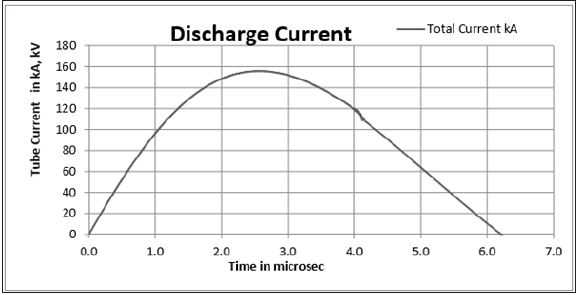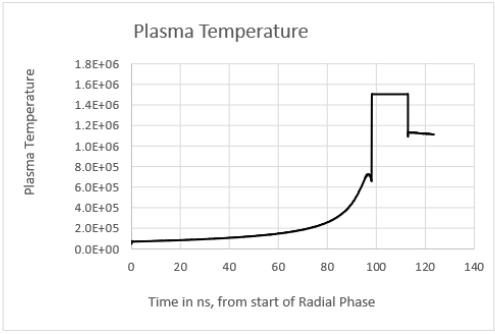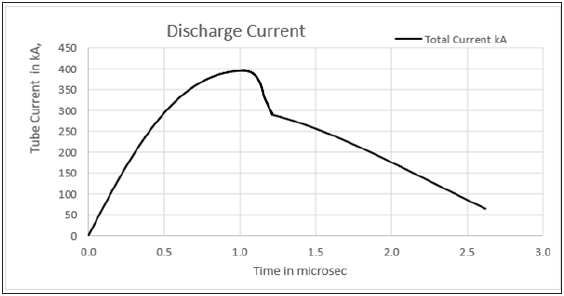- Submissions

Full Text
Evolutions in Mechanical Engineering
Study The Effect of Anode Length on Nitrogen Plasma Pinch Dimensions in NX2 and UNU / ICTP PFF Dense Plasma Focus Devices
Walid Sahyouni1, Alaa Nassif2* and Rasha Yousef1
1Department of Physics, Al-Baath University, Syria
2Faculty of Engineering, Al-Wataniya Private University, Syria
*Corresponding author:Alaa Nassif, Faculty of Engineering, Al-Wataniya Private University, Syria
Submission: September 03, 2021;Published: October 29, 2021

ISSN 2640-9690 Volume3 Issue5
Abstract
In this study, the effect of the difference in anode length in the two dense plasma focus devices NX2 and UNU / ICTP PFF on the resulting nitrogen plasma pinch was studied by performing a numerical simulation of the work of these two devices using Lee’s code. And the study of the change in the dimensions of the pinch when the pressure of nitrogen gas changes in both devices studied. The study showed the effect of the low value of the anode length in the NX2 device on the axial velocity of the plasma layer, and consequently, the arrival of a larger amount of energy stored in the capacitor bank to the compression phase and the formation of the plasma pinch. Also, the change in soft X-rays yield emitted by both devices was studied at the same pressure value P=3 Torr, where the highest value of soft X-rays was Ysxr = 4.5J in the NX2 device and Ysxr = 0.2J in the UNU / ICTP PFF device.
Keywords: Plasma pinch; Lee’s code; Soft X-ray yield
Introduction
Plasma pinch is one of the proposed mechanisms for inducing nuclear fusion in the
laboratory. The term “pinch” applies to a plasma magnetically driven and enclosed by
an electric current flowing through it [1]. There are three types of plasma pinch: Z-pinch,
Ɵ-pinch, and X-pinch. The difference between these types is in the direction of the current
and the resulting magnetic field [2]. Due to their low cost and ease of operation, DPF machines
are considered to be the best devices for producing plasma pinch (Z-pinch). Many studies
have been conducted to study the resulting plasma pinch in dense plasma focus devices in
both its Mather [3] and Filippo [4] models. These studies included mechanisms that form
the plasma pinch from the moment the capacitor bank is discharged until its collapse due
to the absence of plasma instabilities and factors affecting it such as the sheath current. [5]
The pinch current [6], the length of the insulator used to separate the anode and the cathode,
the type of gas used within the device [7,8], the parameters of the capacitor bank [9] and the
electrode geometry ... And radiation emissions from it [10-12].
In this paper, we study the effect of the difference in anode length in two different plasma
focus devices on the dimensions of the formed nitrogen plasma pinch and the result on the
Soft X-Ray (SXR) emission. A numerical simulation was performed using Lee’s code, which is
considered one of the most important programs used to simulate the phenomenon of dense
plasma focus, due to its important features, as it links electrical circuit parameters with the
dynamics and thermodynamics of the plasma focus and radiative emissions, providing a
realistic simulation of all the total properties of the plasma. The basic model is described in
[13]. This program has been used in many incinerated plasma devices such as UNU / ICTP
PFF, NX2, NX1 [14].
Description of the Two Devices
The two studied devices belong to the category of medium energy (1-100kJ) plasma focus devices. These two devices are designed according to the (Mather) model where the ratio of the length of the elevator to its radius is (z/a>1). The two devices studied differ in the geometric dimensions of the poles where the length of the anode in the UNU / ICTP PFF device is (z=16cm) while in the NX2 the length of the anode is (z=5cm) [15].
Results and Discussion
First, numerical experiments were conducted using Lee’s code in order to find the characteristics of the dense plasma focus formed in both studied devices at a specific value for nitrogen gas pressure based on studying the current resulting from the discharge of the capacitor bank, which is considered one of the most important parameters when studying the phenomenon of dense plasma focus:
UNU / ICTP PFF dense plasma focus device
Figure 1 shows the waveform of the discharge current in the UNU / ICTP PFF device from the moment of closing the switch at a nitrogen gas pressure value (3 Torr):
It is noticed from Figure 1 that the highest value of the discharge current is (156kA).
The simulation results showed that the velocity of the plasma layer in the axial phase (vaxial = 5.3cm/μs) and the pinch time of the formed plasma (10.6ns). Also, during the formation of the plasma pinch, the density of the plasma reaches (ni=5.52 × 1023m-3) and its temperature (T=1.5 × 106K), as shown in Figure 2.
Figure 1:The waveform of the discharge current in the UNU/ICTP PFF device.

Figure 2: Plasma temperature during the compression phase.

Dense plasma focus device NX2
Figure 3 shows the path of the discharge current in the NX2 from the moment of closing the switch at a nitrogen gas pressure value (3 Torr):
Note from Figure 4 that the highest value of the discharge current is (395kA).
Figure 3: The waveform of the discharge current in the NX2.

Figure 4: Plasma temperature during the compression phase.

The simulation results showed that the velocity of the plasma layer in the axial phase (vaxial = 7.9cm/μs) and the pinch time of the formed plasma (23.3ns). And that during the formation of the plasma pinch, the density of the plasma reaches (ni = 5.01 × 1023m- 3) and its temperature (T = 1.5 × 106 K), as shown in Figure 4.
Comparing the results, we note the effect of a decrease in the anode length in the NX2 device on the value of the plasma velocity in the axial phase, thus ensuring that a greater amount of the capacitor bank energy reaches the compression phase and thus the value of the radiative releases from the formed pinch plasma.
Secondly, Lee’s code was used to simulate the operation of the two devices when increasing the nitrogen gas pressure to a value after which no focusing occurs, as the pressure range in the UNU / ICTP PFF device was from 0.1 Torr to 4 Torr. In the NX2 device, from 0.2 Torr to 10 Torr, to study the change in plasma pinch during the change in gas pressure. The length and radius of the nitrogen plasma pinch were found in both devices as shown in Table 1 & 2.
Table 1: Dimensions of the plasma pinch when the nitrogen gas pressure changes in the UNU/ICTP PFF device.

Table 2: Dimensions of the plasma pinch when the nitrogen gas pressure changes in the NX2 device.

We note from the results the following
1. The length of the nitrogen plasma pinch formed in the UNU
/ ICTP PFF device ranges from 1.26cm to 1.38cm and the
diameter from 0.081 cm to 0.125cm.
2. The length of the nitrogen plasma pinch formed in the NX2
device ranges from 2.64cm to 2.84cm and the radius ranges
from 0.21cm to 0.26cm.
3. The difference in the dimensions of the plasma pinch
dimensions in the two devices is due to the difference in the
length of the anode, which is in the UNU / ICTP PFF (z=16cm)
and in the NX2 device (z=5cm). The low value of the anode
length in the NX2 ensures that more capacitor bank power
reaches the compression phase, meaning that less energy is
consumed during the movement of the plasma layer along
the length of the elevator, which led to an increase in the size
of the plasma pinch in the NX2 compared to Those that are
configured in the UNU / ICTP PFF device.
4. The results of the study showed that the highest time period
for nitrogen plasma pinch in the UNU / ICTP PFF device was τ
= 13.6ns with an ion density of ni = 9.8 × 1023m-3 while in the
NX2 device, τ = 49.9 ns and ni=19×1023m-3.
5. This difference in the dimensions of the nitrogen plasma
hold, its survival time, and the density of ions within it in both
devices affected the value of the radioactive emissions.
6. The change in Soft X-Rays (SXR) yield was studied when the
pressure of nitrogen gas was changed in both studied devices,
as shown in Figure 5.
Figure 5: The change in soft X-rays yield in the two studied devices when the gas pressure changes.

Figure 5 The change in soft X-rays yield in the two studied devices when the gas pressure changes
It is noticed from the figure that the highest value of the X-ray yield at the same pressure value in both devices is Ysxr = 4.5J in the NX2 device, while Ysxr = 0.2J in the UNU / ICTP PFF device.
References
- Haines MG (2011) A review of the dense Z-pinch. Plasma Physics and Controlled Fusion 53(9): 093001.
- Chung SR (2018) Simulation and characterization of a dense plasma focus device, University of Saskatchewan, Canada.
- Mather JW (1965) Formation of a high‐density deuterium plasma focus. The Physics of Fluids 8(2): 366-377.
- Filippov NV, Filippova TI, Vinogradov VP (1962) Dense high-temperature plasma in a non-cylindrical Z-pinch compression. Nucl Fusion Suppl.
- Rafique MS, Lee P, Patran A, Rawat RS, Lee S (2010) Radiation emission correlated with the evolution of current sheath from a deuterium plasma focus. Journal of fusion energy 29(3): 295-304.
- Lee S, Saw SH (2008) Pinch current limitation effect in plasma focus. Applied Physics Letters 92(2): 021503.
- Al-Hawat S, Akel M, Lee S, Saw SH (2012) Model parameters versus gas pressure in two different plasma focus devices operated in argon and neon. Journal of fusion energy 31(1): 13-20.
- Lee S, Saw SH (2013) Plasma focus ion beam fluence and flux-for various gases. Physics of Plasmas 20(6): 062702.
- Saw SH, Lee S, Roy F, Chong PL, Vengadeswaran V, et al. (2010) In situ determination of the static inductance and resistance of a plasma focus capacitor bank. Review of Scientific Instruments 81(5): 053505.
- Sahyouni W, Nassif A (2018) Neon soft x-ray yield optimization from NX2 dense plasma focus device. Jordan Journal of Physics 11(3): 167-172.
- Walid S, Alaa N (2019) Ions beam properties produced by NX2 plasma focus device with helium and nitrogen gas. American Journal of Modern Physics 8(1): 1-4.
- Sahyouni W, Nassif A (2019) Nitrogen soft x-ray yield optimization from UNU/ICTP PFF plasma focus device. American Journal of Modern Physics 8(6): 86-89.
- Lee S (1984) Plasma focus model yielding trajectory and structure. In Radiation in plasmas. V. 2. Reviews from 1983 college on plasma physics.
- Rawat RS (2017) Plasma science and technology for emerging economies: An AAAPT Experience, Springer.
- Roy FA, Lin CP, Saw SR, Sing L (2010) Generation of Soft X-Ray (SXR) from plasma focus. International Journal of Engineering and Technology 1(1).
© 2021 Alaa Nassif. This is an open access article distributed under the terms of the Creative Commons Attribution License , which permits unrestricted use, distribution, and build upon your work non-commercially.
 a Creative Commons Attribution 4.0 International License. Based on a work at www.crimsonpublishers.com.
Best viewed in
a Creative Commons Attribution 4.0 International License. Based on a work at www.crimsonpublishers.com.
Best viewed in 







.jpg)






























 Editorial Board Registrations
Editorial Board Registrations Submit your Article
Submit your Article Refer a Friend
Refer a Friend Advertise With Us
Advertise With Us
.jpg)






.jpg)














.bmp)
.jpg)
.png)
.jpg)










.jpg)






.png)

.png)



.png)






